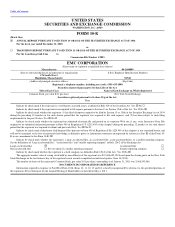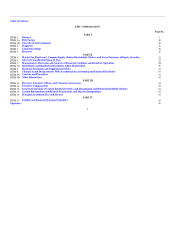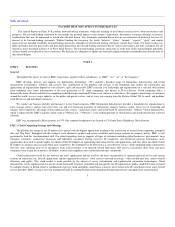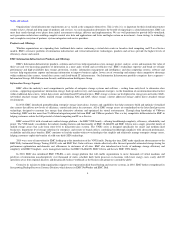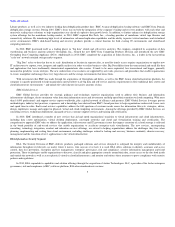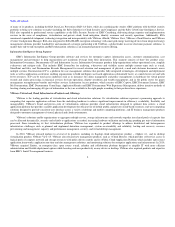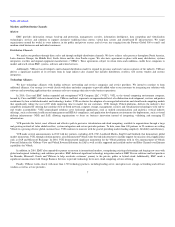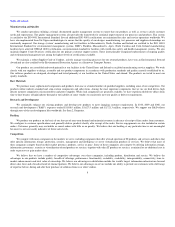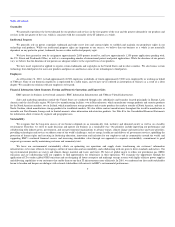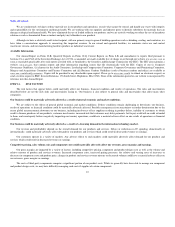EMC 2010 Annual Report Download - page 4
Download and view the complete annual report
Please find page 4 of the 2010 EMC annual report below. You can navigate through the pages in the report by either clicking on the pages listed below, or by using the keyword search tool below to find specific information within the annual report.
Table of Contents
FACTORS THAT MAY AFFECT FUTURE RESULTS
This Annual Report on Form 10-K contains forward-looking statements, within the meaning of the Federal securities laws, about our business and
prospects. The forward-looking statements do not include the potential impact of any mergers, acquisitions, divestitures, securities offerings or business
combinations that may be announced or closed after the date hereof. Any statements contained herein that are not statements of historical fact may be
deemed to be forward-looking statements. Without limiting the foregoing, the words "believes," "plans," "intends," "expects," "goals" and similar
expressions are intended to identify forward-looking statements, although not all forward-looking statements contain these words. Our future results may
differ materially from our past results and from those projected in the forward-looking statements due to various uncertainties and risks, including, but not
limited to, those described in Item 1A of Part I (Risk Factors). The forward-looking statements speak only as of the date of this Annual Report and undue
reliance should not be placed on these statements. We disclaim any obligation to update any forward-looking statements contained herein after the date of
this Annual Report.
PART I
ITEM 1. BUSINESS
General
Throughout this report, we refer to EMC Corporation, together with its subsidiaries, as "EMC", "we", "us", or "the Company."
EMC develops, delivers and supports the Information Technology ("IT") industry's broadest range of information infrastructure and virtual
infrastructure technologies, solutions and services. The combination of our products and services is the foundation that enables the information and
applications all organizations depend on to be effective, agile and successful. EMC's mission is to lead people and organizations on a safe and swift journey
from traditional data center infrastructure to the next generation of IT: cloud computing, also known as IT-as-a-Service. Cloud computing offers a
dramatically more efficient and effective computing model that helps transform IT from a cost center to a value driver. We support a broad range of customers
around the world, in every major industry, in the public and private sectors, and of every size ranging from the Fortune Global 500 to small- and medium-
sized businesses and individual consumers.
We conduct our business globally and manage it in two broad categories. EMC Information Infrastructure provides a foundation for organizations to
store, manage, protect, analyze and secure their vast and ever-increasing quantities of information, improve business agility, lower cost of ownership and
enhance their competitive advantage within traditional data centers, virtual data centers and cloud-based IT infrastructures. VMware Virtual Infrastructure,
which is represented by EMC's majority equity stake in VMware, Inc. ("VMware"), is the leading provider of virtualization and cloud infrastructure software
solutions.
EMC was incorporated in Massachusetts in 1979. Our corporate headquarters are located at 176 South Street, Hopkinton, Massachusetts.
EMC's Cloud Computing Strategy and Offerings
The platform for change in the IT industry has arrived with the biggest opportunity residing at the intersection of trusted cloud computing, enterprise
data and "Big Data." Equipped with the strongest, most distinctive product and services portfolio and strategic partners in company history, EMC is well
positioned to lead this transformational shift. Our cloud computing strategy supports all types of customers including global businesses, governments, large
enterprise customers, commercial businesses and individual consumers. Facing excessive IT complexity and relentlessly-growing information, many
organizations have had to spend roughly two-thirds of their IT budgets on maintaining their infrastructure and applications, and only about one-third of their
IT budgets on advances that can make them more competitive. By enabling IT to be delivered as a cost-effective service, cloud computing helps organizations
alter this ratio, allowing more of an enterprise's focus and investment to be directed toward innovation. CIO surveys consistently show more and more
companies want to gain the economics, flexibility, security and compliance that a cloud infrastructure can provide.
Cloud architectures break the ties between the user's applications and the need for the user's organizations to maintain physical servers and storage
systems on which they run. Instead, applications tap into aggregated resources – from server to network to storage – when needed and, thus, achieve shared
efficiency and agility. This cloud model is made possible by the advent of server virtualization and sophisticated automation technologies. Cloud
infrastructure can be implemented as a private cloud (internal IT resources controlled and managed by the IT organization), public cloud (IT resources shared
by multiple clients) or hybrid cloud (a combination of private cloud and public cloud where resources move between the IT-owned data center and a trusted
service provider). EMC's vision is to be the undisputed leader in enabling hybrid cloud computing through infrastructure and application transformation.
3


